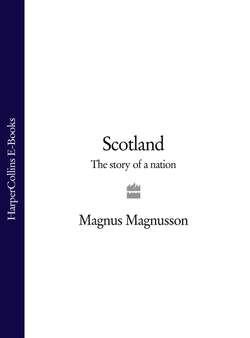Читать книгу Scotland: The Story of a Nation - Magnus Magnusson - Страница 22
The Saltire of Scotland
ОглавлениеHalf a century or more after the Battle of Dunnichen, it is said, there was another battle against the Northumbrians, of symbolic significance at least, which legend associates with the village of Athelstaneford, on the B1347 near Haddington, in East Lothian; this battle is traditionally believed to have provided Scotland with its patron saint, the apostle Andrew, and its banner, the saltire.
According to Walter Bower’s massive Scotichronicon, a Latin history of Scotland written in the 1440s, around 750 a Pictish warrior-king named Unust (729–61) was having the worst of a battle against the Northumbrians, when St Andrew appeared to him in a dream and promised him victory; this boost to Pictish morale apparently did the trick, assisted by another supernatural omen – a huge cloud-formation against the blue sky in the shape of a saltire (a diagonal cross, the crux decussata, on which Andrew was said to have been crucified at Patras in Achaia). Hence the adoption of St Andrew as Scotland’s patron saint, and the blue-and-white saltire banner as the symbol of Scotland’s nationhood.
The early Church in Scotland built up the cult of St Andrew by promoting the story that some of the saint’s relics had been brought to Scotland at the behest of an angel by St Rule (Regulus) in the fourth century; a shrine was built for the relics at Kilrymont, which later became the site of the great cathedral of St Andrews. Having Andrew as its patron saint was a great coup for Scotland: he had been the first of the apostles whom Jesus had called. St Andrews quickly became a renowned centre for evangelisation and pilgrimage.
The tourist trade today is as important to the Scottish economy as the pilgrim trade was then – and Athelstaneford, as ‘the birthplace of Scotland’s flag’, has seen no reason to miss out. In 1965 a commemorative cairn was erected in the graveyard of the parish church, incorporating a granite panel showing two armed hosts facing one another beneath the St Andrew’s Cross in the sky, and the inscription:
Tradition says that near this place in times remote Pictish and Scottish warriors about to defeat an army of Northumbrians, saw against a blue sky a great white cross like Saint Andrew’s, and in its image made a banner which became the flag of Scotland.
Beside the cairn the saltire flies permanently on a tall white flagpole. A Flag Heritage Centre was established there in 1996 in a converted sixteenth-century doocot (dovecote).
